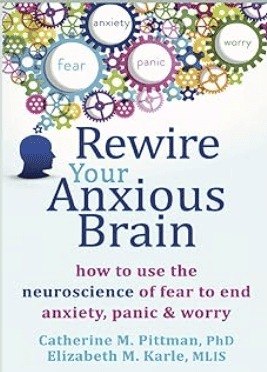
Introduction: Rewire Your Anxious Brain by Catherine M. Pittman and Elizabeth M. Karle
Rewire Your Anxious Brain by Catherine M. Pittman and Elizabeth M. Karle is a neuroscience-based guide that explains how anxiety works in the brain and offers practical strategies to manage it. The book delves into the neurological roots of anxiety, illustrating how two different brain pathways, the amygdala and the cortex, contribute to anxiety, panic, and worry. By understanding these pathways, individuals can “rewire” their brains to reduce stress and improve mental well-being.
The book is structured around the two primary pathways that fuel anxiety: the amygdala and the cortex. Both parts of the brain contribute to different types of anxiety and understanding how they work allows us to better manage our responses to fear, panic, and worry.
Table of Contents
Key Concepts
1. Two-Pathway Model of Anxiety
– The book introduces the two distinct brain pathways responsible for anxiety:
1. The Amygdala Pathway: A primitive, emotional response system that triggers anxiety based on instinctual and emotional stimuli. It often bypasses rational thought, which leads to intense and sudden fear responses like panic.
2. The Cortex Pathway: A more analytical, slower process that generates anxiety through thoughts, interpretation, and conscious worry. It tends to create anxiety over future events and hypothetical situations.
Understanding how these two pathways contribute to anxiety can help in recognizing and managing different anxiety triggers.

Do you ever wonder what is happening inside your brain when you feel anxious, panicked, and worried? In Rewire Your Anxious Brain, psychologist Catherine Pittman and author Elizabeth Karle offer a unique, evidence – based solution to overcoming anxiety based in cutting – edge neuroscience and research. In the book, you will learn how the amygdala and cortex (both important parts of the brain) are essential players in the neuropsychology of anxiety. (Source: Amazon)
Rewire Your Anxious Brain: How to Use the Neuroscience of Fear to End Anxiety, Panic and Worry (16pt Large Print Edition)
The Amygdala Pathway
The amygdala is an almond-shaped structure in the brain that governs fear and the fight-or-flight response. This pathway is responsible for automatic and unconscious anxiety reactions. When the amygdala perceives a threat (real or imagined), it triggers a fear response, releasing stress hormones like adrenaline and cortisol.
– Panic and Phobias: The amygdala is often responsible for panic attacks and phobias. The body reacts to a trigger almost instantaneously, without input from the cortex (rational thinking). This can lead to overwhelming feelings of fear or terror, often disproportionate to the actual threat.
– Emotional Memories: The amygdala stores emotional memories, which can trigger anxiety later in life. For instance, someone might experience a panic attack when they smell a particular scent that they unconsciously associate with a past trauma.
Strategies to Rewire the Amygdala Pathway
– Exposure Therapy: One effective way to rewire the amygdala is through exposure therapy. This involves gradually and safely confronting anxiety-inducing situations until the brain learns that these situations are not as threatening as they once perceived.
– Relaxation Techniques: Since the amygdala reacts automatically, practicing relaxation techniques like deep breathing, mindfulness, and progressive muscle relaxation can help reduce the immediate physical symptoms of anxiety (e.g., rapid heartbeat, sweating).
– Repetition and Habituation: Rewiring the amygdala involves teaching it new, non-anxious responses to triggers. This can only be achieved through repeated exposure and habituation to what once caused fear. Over time, the amygdala learns that these triggers are safe, and anxiety decreases.
The Cortex Pathway
The cortex is the thinking part of the brain responsible for reasoning, decision-making, and planning. Thoughts and concerns about the future or negative interpretations of events drive anxiety generated by the cortex.
– Worry and Rumination: The cortex is responsible for chronic worry, rumination, and what-if scenarios. It often involves overthinking and catastrophizing, where one imagines worst-case outcomes even in non-threatening situations.
– Cognitive Distortions: The cortex can generate anxiety through distorted thinking patterns, such as all-or-nothing thinking, overgeneralization, and jumping to conclusions. These distorted thoughts can amplify anxiety unnecessarily.
Strategies to Rewire the Cortex Pathway
– Cognitive Behavioral Therapy (CBT): CBT is one of the most effective techniques for rewiring the cortex. It involves recognizing and challenging irrational thoughts and replacing them with more balanced, realistic interpretations. By doing this consistently, the cortex can develop healthier thought patterns, reducing anxiety.
– Mindfulness and Meditation: Practicing mindfulness helps individuals observe their thoughts without judgment and detach from unhelpful thought patterns. Meditation trains the brain to remain present, preventing the cortex from wandering into anxious thoughts about the future.
– Positive Self-Talk: Rewiring the cortex involves creating new, positive internal dialogues. Instead of focusing on negative outcomes, training the brain to use encouraging and supportive self-talk can help reduce anxiety.
The Role of Neuroplasticity
The concept of neuroplasticity is central to the book. Neuroplasticity is the brain’s ability to change and reorganize itself by forming new neural connections throughout life. This ability to rewire the brain means that even if someone has suffered from chronic anxiety for years, it is possible to change the brain’s anxiety response through consistent practice and repetition of new behaviors and thought patterns.
Practical Techniques to Rewire Your Anxious Brain
1. Breathing Techniques: One of the quickest ways to calm anxiety is through deep, controlled breathing. This helps activate the parasympathetic nervous system, which calms the body’s fight-or-flight response triggered by the amygdala.
2. Exercise: Physical activity reduces the stress hormones in the body and promotes the release of endorphins, which naturally reduce anxiety. Exercise also helps to rewire the amygdala by associating physical movement with positive feelings rather than stress.
3. Mindful Awareness: Mindfulness practices help individuals stay present in the moment, rather than getting caught up in the future-oriented worries that the cortex generates. By focusing on the present, individuals can reduce the frequency and intensity of anxious thoughts.
4. Challenging Irrational Thoughts: For cortex-based anxiety, it is important to identify cognitive distortions and irrational thoughts that contribute to anxiety. Challenging these thoughts with logic and evidence can help the brain form more rational responses.
5. Relaxation and Visualization: Visualization techniques, such as imagining a calm, safe place, can help reduce anxiety by creating a positive mental association. This is particularly useful for rewiring the amygdala, as it helps counteract the emotional memory of fear with one of peace and safety.
The Importance of Sleep, Nutrition, and Self-Care
The book emphasizes that brain health, in general, plays a crucial role in anxiety management. Poor sleep, poor nutrition, and lack of self-care can exacerbate anxiety. The following lifestyle changes can support brain rewiring efforts:
– Adequate Sleep: Sleep is essential for emotional regulation. The brain processes and consolidates memories during sleep, which can help reduce the emotional intensity of anxious experiences.
– Balanced Diet: Proper nutrition supports overall brain health. Diets rich in omega-3 fatty acids, vitamins, and minerals support cognitive functioning and reduce inflammation, which can play a role in anxiety.
– Limiting Stimulants: Caffeine and sugar can exacerbate anxiety symptoms by triggering physical responses (like increased heart rate) similar to panic. Reducing or eliminating these substances can help decrease baseline anxiety.
Integration of Strategies for Long-Term Anxiety Management
The authors stress that rewiring the anxious brain is a long-term process requiring consistency and practice. Techniques that work for one person may not work for another, so experimentation and persistence are key. Integrating both amygdala- and cortex-based strategies ensures that individuals can manage a wide range of anxiety symptoms, whether they arise from emotional triggers or cognitive worry.
Case Studies and Practical Applications
Throughout the book, Pittman and Karle provide real-life examples and case studies to illustrate how the brain’s anxiety pathways operate in various situations. These examples help readers see how to apply the concepts and techniques to their own lives. The case studies also demonstrate how different individuals may need to focus on either the amygdala or cortex pathway depending on their specific anxiety triggers.
Conclusion: Rewire Your Anxious Brain
In conclusion, Rewire Your Anxious Brain presents a clear and comprehensive understanding of how anxiety functions in the brain, focusing on the amygdala and cortex as the primary drivers of fear, panic, and worry. The book empowers readers by showing that anxiety is not an uncontrollable force but rather a series of learned responses that can be changed through intentional effort and brain retraining. By practicing techniques that calm the amygdala’s automatic fear response and restructuring the cortex’s anxious thought patterns, individuals can rewire their brains, leading to long-term reduction in anxiety.
Through a combination of mindfulness, cognitive-behavioral techniques, exposure therapy, and lifestyle adjustments, the book offers a scientifically grounded approach to overcoming anxiety and improving mental health.
Reviews of “Rewire Your Anxious Brain” by Catherine M. Pittman and Elizabeth M. Karle:
Review 1: Comprehensive and Scientifically Grounded
“Rewire Your Anxious Brain” is an outstanding book that breaks down the complex neuroscience of anxiety in a way that is easy to understand and apply. I loved how the authors focused on both the amygdala and cortex pathways, providing a two-pronged approach to managing anxiety. The explanations are backed by science, but the writing is still accessible to the average reader. The practical techniques—like mindfulness, cognitive restructuring, and exposure therapy—are well explained, and I’ve found them incredibly helpful in managing my anxiety. Highly recommend this book to anyone struggling with fear, worry, or panic!
Review 2: A Game-Changer for Anxiety Sufferers
This book truly changed the way I understand my anxiety. Before reading Rewire Your Anxious Brain, I always felt like my anxious responses were out of my control. Now I understand how different parts of my brain are responsible for various types of anxiety, which has given me a sense of control over my reactions. The amygdala and cortex pathways are explained in a simple yet profound way, and the tools provided to “rewire” your brain are actionable and effective. I particularly benefited from the cognitive-behavioral strategies for cortex-based anxiety. A must-read for anyone looking to take charge of their mental health.
Review 3: Insightful but Somewhat Repetitive
I appreciated the scientific approach in Rewire Your Anxious Brain, especially the detailed explanation of the brain’s role in anxiety. The book does a great job of explaining how fear and anxiety are triggered by both automatic responses (amygdala) and thought patterns (cortex). However, I found some of the content to be repetitive, particularly when discussing the same techniques in different sections. While the strategies are solid and backed by research, the repetition slowed down the reading experience for me. Still, the book offers valuable insights for anyone struggling with anxiety and is worth checking out.
Review 4: Practical, Accessible, and Empowering
Rewire Your Anxious Brain is a practical guide to understanding and managing anxiety. What I loved most about this book is that it doesn’t just focus on symptoms but gets to the root of how anxiety is formed in the brain. The amygdala and cortex distinction made so much sense, and it helped me pinpoint where my anxiety was coming from. The techniques suggested, like exposure therapy for the amygdala and cognitive restructuring for the cortex, are easy to implement. I also appreciated the case studies, which made the concepts more relatable. This book is an empowering tool for anyone looking to reduce their anxiety.
Review 5: A Bit Heavy on Neuroscience, but Worthwhile
As someone new to the science of anxiety, I found Rewire Your Anxious Brain to be informative but at times a bit heavy on the neuroscience. The sections on the amygdala and cortex are very detailed, and while I found the information useful, it took me some time to fully grasp the scientific concepts. That said, the book offers excellent practical advice on how to manage anxiety. I found the mindfulness techniques and the emphasis on neuroplasticity particularly helpful. If you’re looking for a deeper understanding of anxiety from a brain science perspective, this book is for you—but be prepared for a somewhat technical read.
Other posts you might be interested in:

